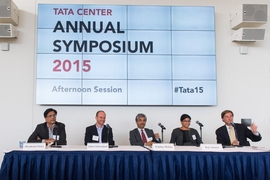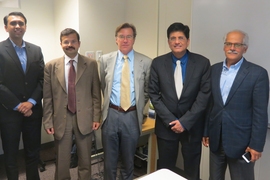More than 300 million people in India have no access to grid electricity, and the problem is especially acute in rural communities, which can be difficult and expensive to reach with grid power.
At MIT’s Tata Center for Technology and Design, researchers are exploring ways to extend electricity access to such communities using microgrids — independent electricity generation and distribution systems that service one village or even just a few houses. In addition to being flexible in size, microgrids can run on whatever power sources are available, including wind, hydropower, and the source accessible at all sites: solar power.
“A large number of people, particularly in rural India, won’t be electrified for decades, and the situation is similar in other parts of southern Asia and sub-Saharan Africa. The statistics say that 1.5 billion people worldwide lack access to electricity, but many more don’t have reliable access,” says Robert Stoner, deputy director for science and technology at the MIT Energy Initiative (MITEI) and director of the Tata Center. “We’re looking for ways to make electricity available to everyone without necessarily having to go through the costly and time-consuming process of extending the [national] electric grid. With policy support in the form of regulation and financing … it’s conceivable that microgrids could proliferate very quickly. They might not supply a level of access equivalent to that offered by a well-managed grid but would provide an affordable and significant step forward in quality of life.”
Microgrids can be powered by diesel generators or by renewable technologies, among them solar power, which is becoming more attractive as the cost of solar technology falls. “If you use solar, [the fuel is] essentially free,” says Rajeev Ram, MIT professor of electrical engineering and a Tata Center researcher. In addition, he says, “microgrids are attractive because they let you pool resources.”
Nevertheless, the widespread adoption of microgrids has been stymied by several challenges, including the high cost of setting up private generation and distribution systems and the business risk of investing in a system that’s susceptible to being undercut by an extension of the electric grid.
At the Tata Center, researchers are addressing such concerns from multiple angles — from mapping out national electrification networks, to providing planning assistance to rural entrepreneurs, to developing technology that can make it easier to build microgrids organically, from the grassroots up. Indeed, the researchers say that properly designed microgrids can be grid-compatible, reducing the risk to investors and providing an intermediate stage to grid connection where this is technically and economically viable.
“Everyone agrees we have to scale microgrids” to address the rural electrification gap, says Brian Spatocco, a Tata Fellow who worked on microgrids as a PhD candidate in materials science and engineering at MIT. The problem, he says, is that “not one size fits all.”
Reference electrification model
To address the microgrid challenge at the macro level, Tata researchers led by Stoner and Ignacio Pérez-Arriaga, a visiting professor at the MIT Sloan School of Management from IIT-Comillas University in Madrid, Spain, have been developing and implementing a sophisticated computer program that can help government planners determine the best way to provide electricity to all potential consumers.
The Reference Electrification Model (REM) pulls information from a range of data sets — which in India include satellite imagery, the Census of India, and India’s National Sample Survey, which gathers statistics for planning purposes. REM then uses the data to determine where extending the grid will be most cost-effective and where other solutions, such as a microgrid or even an isolated home solar system, would be more practical.
“We are approaching the problem of rural electrification from the perspective of planners and regulators,” Stoner says.
Satellite imagery is used to map the buildings in a given location, and demand is estimated based on the types and profiles of the buildings. REM then uses pricing and technical data on such equipment as solar panels, batteries, and wiring to estimate the costs of electrification on or off the grid and to make preliminary engineering designs for the recommended systems. The model essentially produces a snapshot of a lowest-cost electrification plan as if one could be built up overnight.
“This is a technology tool that [officials] can use to inform policy decisions,” says Claudio Vergara, a MITEI postdoc working on the REM project. “We’re not trying to tell them what the plan should be, but we’re helping them compare different options. After a decision has been made and detailed information about the sites is gathered, REM can be used to produce more detailed designs to support the implementation of each of the three electrification modes.”
Currently, Tata researchers are using REM to model an electrification plan for Vaishali, a district of 3.5 million people in the state of Bihar in India. “We’re designing the system down to every house,” Stoner says.
In the project, results from REM were used to identify the best locations in Vaishali for microgrids (see Figure 1 in the slideshow above). In July 2015, the team visited two candidate sites, each with between 70 and 250 houses, and REM will now be used to produce a detailed technical design showing all the equipment and wiring needed to electrify them. Then, Vergara says, a local Tata partner will put REM to the test by actually building the microgrids. “The pilot will help us improve the model,” Vergara says. “We’re making many modeling assumptions now, so we need real-world validation.” Once the software has been perfected, Stoner says, the researchers plan to make it openly available.
GridForm
Another project under way at the Tata Center addresses the barriers to entry for potential microgrid entrepreneurs. Such businesses face several hurdles, including the high cost of determining the most cost-effective sites for their projects. India’s government and public utilities often provide no information about where the electric grid is likely to be extended next, and calculating the likely demand for electricity in a village typically requires costly, on-the-ground research — all of which makes it tough for any potential microgrid entrepreneur to make the case for profitability and to secure financing.
Three MIT graduate students and a postdoc are working to develop GridForm, a planning framework that rapidly identifies, digitizes, and models rural development sites, with the goal of automating some of the work required to design a microgrid for a small village.
“Doing a custom system for every village creates so much work for companies — in time and in the human resources burden — that it can’t scale,” Spatocco says. “We’re trying to expedite the planning piece so [entrepreneurs] can serve more people and reduce costs.”
Like REM, GridForm begins with satellite data, but GridForm goes on to use advanced machine learning to model individual villages with a high level of detail. “We’ll say this is a house and this is a house, hit run, and the machine learns the properties of a house, such as size and shape,” Spatocco says. The goal is to produce a hardware and cost model of a target village that is 90 percent accurate before anyone even visits the site.
GridForm also develops load estimates, based on factors such as demographics and the proximity of buildings, and provides entrepreneurs with potential microgrid designs and even lists of necessary equipment. The program incorporates data sets on solar radiance and uses an algorithm to determine the best configuration of solar panels, battery packs, and distribution wires to power the greatest number of houses at the lowest cost.
“We’re providing everything from siting to planning to implementation — the whole process,” says Kendall Nowocin, a PhD student in electrical engineering and computer science working on GridForm. The other two researchers working on the project are George Chen PhD ’15, an MITx postdoctoral teaching fellow, and Ling Xu, a PhD student in health sciences and technology.
The main difference from REM, the researchers say, is that GridForm envisions electrification being built from the ground up rather than from the top down. “We think rural entrepreneurs will electrify themselves,” Spatocco says. “We want to create insights that are immediately useful to practitioners on the ground — what to buy, what it will cost, where to put it.”
Already GridForm has been used to develop detailed microgrid plans for four villages in the state of Bihar, and the team is working with Indian social enterprise SELCO Solar to do the installations, providing service to 2,000 to 3,000 people.
uLink
A third Tata Center project focuses on fostering the organic growth of microgrids by enabling residents to share extra power-generating capacity with their neighbors via an inexpensive piece of hardware, the uLink power management unit (PMU).
A “demand response” system that meters and controls the flow of electricity, uLink can adjust the demands it serves based on the supply of electricity that’s available. The system reflects an innovative approach to electrification, Ram says — one that acknowledges that the standards for electrification common in the developed world are unrealistically high for poor, remote areas. Building in the system redundancies necessary to ensure 99.9 percent availability is simply too expensive — and particularly unrealistic in India, where even the areas served by the grid are plagued by power outages.
“Here we can guarantee a basic level of service, but we don’t guarantee 99.9 percent,” Ram says. “This is a very powerful way to manage the cost of electricity infrastructure. Demand response allows you to size the system for average demand, versus peak demand.”
What that means is that when the sun is shining and batteries are fully charged, microgrid customers can run all of their appliances, but when it’s been cloudy for a few days and the system is low on power, uLink can signal users to shut off loads; as a last resort, it can even shut off loads automatically. Automating this function eases the social difficulty of sharing electricity, the researchers say. Once users have pooled their resources, there’s no need to argue over who can use which appliances; uLink allots electricity based on which loads have been predetermined as “critical” and therefore not subject to shutoff when system demand peaks. Everything else can be shut off by uLink as needs arise.
Users themselves determine which few loads are “critical,” providing an element of choice not typically seen in home solar systems, which hardwire their loads. uLink features several outlets, enabling users to plug in a variety of appliances. At maximum capacity, the initial prototype low-voltage, DC system provides about 25 watts per household, enough to run a fan, a cellphone charger, and a couple of lights.
“The hardest part is making a box with all these functions at a cost people can afford,” Ram says, noting that the uLink consumer unit is designed to cost about as much as a cellphone, making it affordable for most Indian villagers.
uLink was field-tested in June 2015 — five houses were wired together for two weeks — and the delivery, metering, and networking systems worked well. The next milestone for the developers is to test the algorithm designed to estimate how much electricity is available from the system’s batteries and solar panels and optimally shed loads. “This is definitely a work in progress,” Ram says.
Indeed, all three Tata Center projects are still being refined, but together they offer a rich portfolio of potential solutions to the problem of rural electrification, the effects of which many of the researchers have seen firsthand.
“Electricity is not just empowering. It’s an enabling force. Electricity goes right into livelihood activities,” Spatocco says, noting that just a few lights make it possible for residents to work in the evenings, for example, or to improve their efficiency with simple machinery, such as sewing machines. “People can double or triple their economic output.”
There are also benefits few in the West might imagine, as Ram discovered by interviewing residents of one non-electrified Indian village: “They conveyed how frightening it can be to have a snake in the village if no one has a light.”
This research was supported by the MIT Tata Center for Technology and Design. Work on GridForm also received support from the MIT IDEAS Global Challenge. The REM program also benefited from other studies undertaken outside India supported by ENEL Foundation and Iberdrola.
This article appears in the Autumn 2015 issue of Energy Futures, the magazine of the MIT Energy Initiative.













